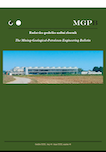Identification and detection of a void under highway cement concrete pavement slabs based on finite element analysis
DOI:
https://doi.org/10.17794/rgn.2019.3.5Keywords:
finite element analysis, void under slabs, cement road, acoustic vibration methodAbstract
For a city, the construction of a road is related to the development of economy, and the construction of a road includes maintenance of the road. Cement roads have been popularized in road construction due to their low construction cost and high strength, but at the same time, road problems have arisen. In order to solve and prevent the problem of voids under highway cement concrete pavement slabs, the acoustic vibration method was used for the detection of voids under highway cement concrete pavement slabs. This method was briefly introduced and analysed with finite element analysis. Then, excitation equipment and ABAQUS software were used to perform instance analysis on the section from K08-000 to K09-000 of G325 National Road. The results showed that there were three situations, including a mild void, normal void and serious void. The degree of abrupt change of the peak amplitude of the acoustic vibration characteristic curve increased with an increase in the severity of the void under the highway cement concrete pavement slabs. The void area was obtained through calculation of the sound pressure characteristic curve data based on the finite element model, with an error between 17.0 and 21.9%. However, in road maintenance projects, this error is acceptable. In summary, the acoustic vibration method based on finite element analysis can effectively detect the position of a void under highway cement concrete pavement slabs and estimate the area.
Downloads
Published
How to Cite
Issue
Section
License
Copyright (c) 2019 authors and journal

This work is licensed under a Creative Commons Attribution 4.0 International License.
Creative Commons-BY
Authors who publish with this journal agree to the following terms:
In agreeing this form, you certify that:
- You read the ethical codex of the RGN zbornik available at journal web.
- You submitted work is your original work, and has not previously been published and does not include any form of plagiarism.
- You own copyright in the submitted work, and are therefore permitted to assign the licence to publish to RGN zbornik.
- Your submitted work contains no violation of any existing copyright or other third party right or any material of an obscene, libellous or otherwise unlawful nature.
- You have obtained permission for and acknowledged the source of any illustrations, diagrams or other material included in the work of which you are not the copyright owner.
- You have taken due care to ensure the accuracy of the work, and that, to the best of your knowledge, there are no false statements made within it.
- All co-authors of this submitted work are aware of, and in agreement with, the terms of this licence and that the submitted manuscript has been approved by these authors.
Publication licence
You retain copyright in your submitted work, according to journal license policy (CC-BY). By signing this form you agree that RGN zbornik may publish it under the publication licence. In summary the licence allows the following:
Anyone is free:
- To copy, distribute, display, and perform the work.
- To make derivative works.
Under the following conditions:
- The original author must always be given credit.
- The work may not be used for commercial purposes.
- If the work is altered, transformed, or built upon, the resulting work may only be distributed under a licence identical to this one.
Exceptions to the licence
In addition to publishing the work printed under the above licence, RGN zbornik will also enable the work to be visible online.
The journal editorial can change the licence rules anytime but it cannot retroactively restrict author(s) rights.


